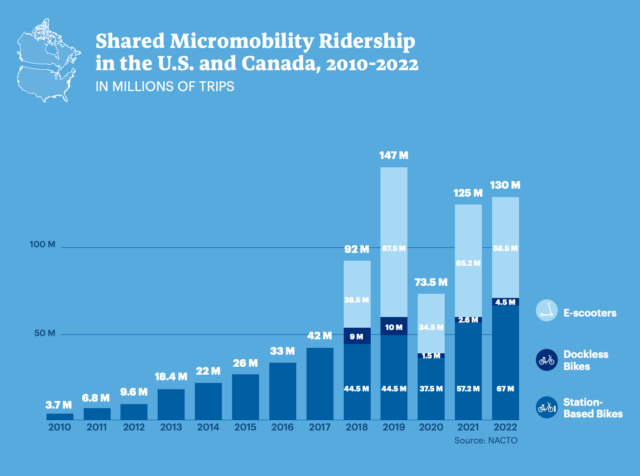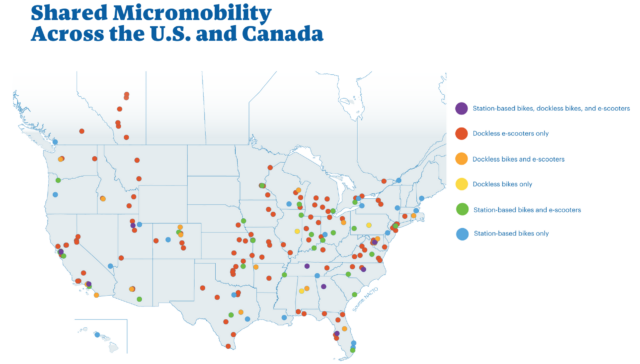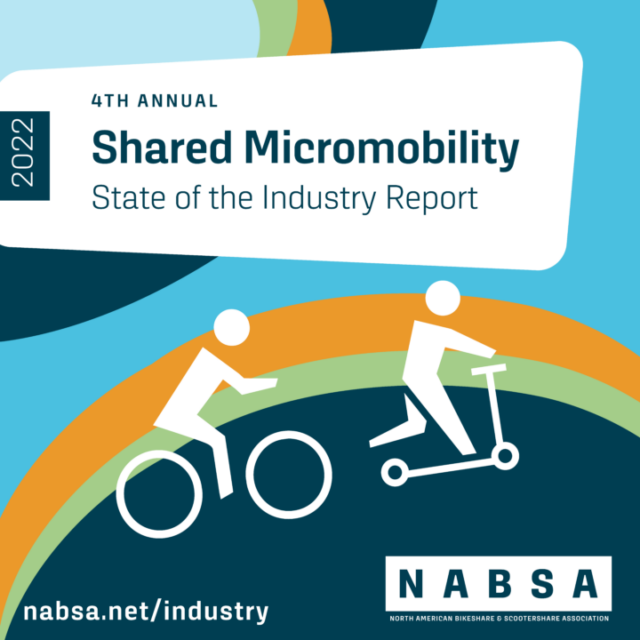NACTO’s 2022 Shared Micromobility Report is Here
by Kiran Herbert, Communications Manager
November 7, 2023
Data from the U.S. and Canada shows how shared bikes and scooters have changed transportation, providing safer, cheaper, and more accessible ways for people to get around.
 Since 2010, more than 730 million trips have been taken on shared bikes and e-scooters in the U.S. and Canada. It’s safe to say that shared micromobility (SMM) has become an ever-more integrated and indispensable part of urban transportation systems across these two countries — not only have many systems weathered the pandemic but more cities currently have shared micromobility services than ever before. Bike share and e-scooter systems are taking cars off the road, reducing greenhouse gas emissions, and getting people where they need to go.
Since 2010, more than 730 million trips have been taken on shared bikes and e-scooters in the U.S. and Canada. It’s safe to say that shared micromobility (SMM) has become an ever-more integrated and indispensable part of urban transportation systems across these two countries — not only have many systems weathered the pandemic but more cities currently have shared micromobility services than ever before. Bike share and e-scooter systems are taking cars off the road, reducing greenhouse gas emissions, and getting people where they need to go.
The National Association of City Transportation Officials’ (NACTO) 2022 Shared Micromobility in the U.S. and Canada Report helps paint a more detailed picture of the transportation revolution SMM has brought about. Building on prior research, the 2022 report examines data from across North America to identify the changes and trends that have emerged in the past year, and the key factors that may shape shared micromobility programs in the years ahead. The report also notes the work that remains to ensure that shared micromobility devices are affordable and accessible to everyone, including prioritizing equitable distribution and pricing.
“Shared bikes and e-scooters are a key part of daily life for communities across North America,” says Corinne Kisner, executive director of NACTO. “We cannot take this success for granted. To ensure shared micromobility systems continue to grow sustainably and equitably, local leaders must advance safe street design and thoughtful pricing policies in close partnership with operators.”
Highlights of the 2022 Report:
More people took bike share trips in 2022 than any previous year on record.
People took at least 130 million trips on shared bikes and e-scooters in the U.S. and Canada in 2022, and trips are up by 40% since 2018. In the U.S., SMM continued its pandemic-era recovery with 113 million trips, while Canada blew past its pre-pandemic highs with 17 million trips.

Systems have become an ever-more integrated and indispensable part of urban transportation networks.
While rush hour peaks in the mornings and evenings returned for many, people continued to use shared micromobility for all kinds of non-work trips. An analysis of some of the largest systems found that 34% of riders use shared micromobility to access jobs, while 39% use shared micromobility to run errands, 16% to get to school, and 50% for other social or recreational trips.
The e-bike boom of previous years continued into 2022, especially on station-based bike share systems.
Three-quarters of all station-based systems across the U.S. and Canada expanded the number of e-bikes in their fleets, and in the U.S. alone, total station-based e-bike trips increased from 14.5 million trips in 2021 to 20 million trips in 2022. Station-based e-bikes made up only 9% of available shared micromobility devices in the U.S. and Canada in 2022, yet accounted for 18% of total trips.
The cost of riding shared micromobility is climbing, and to keep shared micromobility affordable, cities must set clear goals for pricing and price equity.
 In 2022, annual membership hikes and rising e-bike surcharges led to a 70% increase in average per-trip costs for station-based bike share members from the previous year. Still, membership prices were more affordable than pay-as-you-go costs, which typically exceeded the price of a one-way trip on public transit. For short trips, SMM is often faster than waiting for a bus but if it’s more expensive, it’s not a realistic option for those who are price-sensitive.
In 2022, annual membership hikes and rising e-bike surcharges led to a 70% increase in average per-trip costs for station-based bike share members from the previous year. Still, membership prices were more affordable than pay-as-you-go costs, which typically exceeded the price of a one-way trip on public transit. For short trips, SMM is often faster than waiting for a bus but if it’s more expensive, it’s not a realistic option for those who are price-sensitive.
Reduced-fare options offer steep discounts for those who qualify, but the shift towards per-minute pricing structures threatens affordability for people traveling from further neighborhoods into urban cores. People using reduced-fare passes are 2x more likely to use e-bikes than pedal bikes, and a 2-4 mile trip that was once affordable can now cost $6.00 or more, even with a reduced-fare pass.
Long-term investments in on-street infrastructure, like protected bike lanes, lead to more people riding shared bikes and e-scooters.
Studies from across the U.S. and Canada show that more people ride bikes when cities build high-quality, protected bike lanes. Cities that have invested in bike networks built for people of all ages and abilities have seen tremendous growth in shared micromobility ridership over the past decade.
For example, Austin, Texas, built 100 miles of new bike lanes between 2018 and 2022 and continued to be one of the top U.S. cities for shared micromobility ridership in 2022, with 3.4 million trips on dockless bikes and e-scooters and over 300,000 trips on station-based bike share.
Close collaboration between cities and shared micromobility providers is critical for equitable outcomes.
Increasing volatility amongst private-sector operators poses a concern for the long-term viability of shared micromobility programs in North America. Programs that are municipally owned or closely managed through long-term contracts tend to stick around and see better outcomes on pricing equity and access in historically underserved communities.
Cities like New Orleans, Pittsburgh, and Denver have recently restructured their shared micromobility programs with these priorities in mind, aiming for more sustainable operations, equitable distribution of devices, and affordability — especially with the rising costs of electric bikes and e-scooters.

Taken as a whole, the report leaves no doubt that shared bikes and e-scooters are popular and highly valued in the U.S. and Canada. However, it’s also clear that systems that work hand in hand with the communities they serve see better outcomes, like more availability in historically underserved neighborhoods or more affordable pricing.
“This report shows that people are using shared micromobility to not only recreate but to access essential services,” says Tangier Barnes Wright, BBSP’s senior partnerships and program manager. “When done right, shared micromobility serves the same role as public transportation and cities should be treating it as such.”
As more systems and operators shift to offering e-bikes, prioritizing equitable distribution and pricing will continue to be a top concern, especially with many systems financed by for-profit tech companies facing uncertainty in their operations. Shared micromobility can be an extraordinarily competitive and reliable transportation option for short trips, but only with holistic planning, clear policy and goal-setting, and close collaboration between cities and operators.
The report also emphasizes how the increasing popularity of bikes and scooters necessitates new thinking on how we design our streets, including adding wider bike lanes that accommodate more people traveling at different speeds. One billion trips on shared bikes and scooters is just around the corner, and cities that form strong partnerships with both their operators and the communities they serve will be the ones that lead the way.
👉🏽DOWNLOAD THE FULL REPORT HERE👈🏽
The Better Bike Share Partnership is funded by The JPB Foundation as a collaboration between the City of Philadelphia, the National Association of City Transportation Officials (NACTO), and the PeopleForBikes Foundation to build equitable and replicable bike share systems. Follow us on LinkedIn, Facebook, Twitter, and Instagram, or sign up for our weekly newsletter. Have a question or a story idea? Email kiran@peopleforbikes.org.



